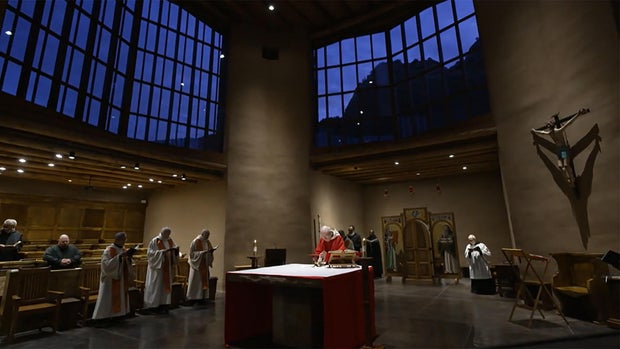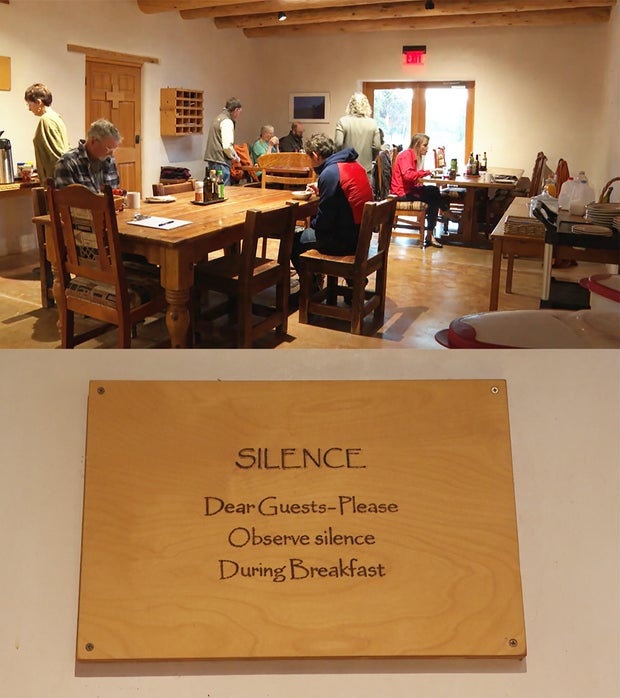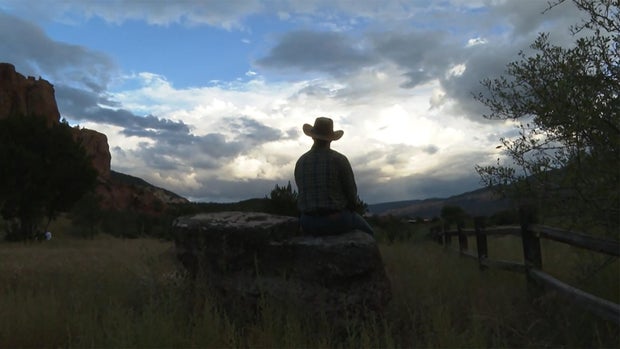New Mexico
New Mexico Denies Film Incentive Application on Alec Baldwin’s ‘Rust’ Movie After Fatal Shooting

Producers of the western movie Rust may have to forgo a robust economic incentive as they try to sell the film to distributors and fulfill financial obligations to the immediate family of a cinematographer who was fatally shot by Alec Baldwin during rehearsal in 2021.
New Mexico tax authorities denied an application this spring by Rust Movie Productions for incentives worth as much as $1.6 million, according to documents obtained by The Associated Press. A late July deadline for producers to appeal the decision is approaching.
Meanwhile, Baldwin is scheduled to go on trial starting next week on an involuntary manslaughter charge in Halyna Hutchins’ death. The lead actor and co-producer of Rust was pointing a gun at Hutchins when it went off, killing her and wounding director Joel Souza.
Melina Spadone, an attorney representing the production company, said the film production tax incentive was going to be used to finance a legal settlement between producers and Hutchins’ widower and son.
“The denial of the tax credit has disrupted those financial arrangements,” said Spadone, a New York- and Los Angeles-based senior counsel at Pillsbury Winthrop Shaw Pittman. She helped broker the 2022 settlement that rebooted the stalled production of Rust in Montana with some of the original cast and crew, including Baldwin and Souza. Filming wrapped up last year.
Terms of the settlement are confidential, but producers say finishing the film was meant to honor Hutchins’ artistic vision and generate money for her young son.
Court documents indicate that settlement payments are up to a year late, as attorneys for Hutchins’ widower determine “next steps” that include whether to resume wrongful death litigation or initiate new claims. Legal representatives for Matthew Hutchins did not respond to telephone and email messages seeking comment.
The prosecution of Baldwin and the film’s tax incentive application both have financial implications for New Mexico taxpayers. The Santa Fe district attorney’s office says it spent $625,000 on Rust-related prosecution through the end of April.
The state’s film incentives program is among the most generous in the nation, offering a direct rebate of between 25% and 40% on an array of expenditures to entice movie projects, employment and infrastructure investments. As a percentage of the state budget, only Georgia pays out more in incentives.
It includes a one-time option to assign the payment to a financial institution. That lets producers use the rebate to underwrite production ahead of time, often layering rights to the rebate and future movie income into production loans.
Among the beneficiaries of the rebate program are the 2011 movie “Cowboys and Aliens” and the TV series “Better Call Saul,” a spinoff of “Breaking Bad.” As for current productions, New Mexico is the backdrop for a new film starring Matthew McConaughey and America Ferrera about the rescue of students in a 2018 wildfire in the town of Paradise — the most destructive in California’s history.
Charlie Moore, a spokesperson for the New Mexico Taxation and Revenue Department, declined to comment specifically on the Rust application, citing concerns about confidential taxpayer information. Applications are reviewed for a long list of accounting and claim requirements.
During a recent 12-month period, 56 film incentive applications were approved and 43 were partially or fully denied, Moore said.
Documents obtained by AP show the New Mexico Film Office issued a memo in January to Rust that approved eligibility to apply for the tax incentive, in a process that involves accounting ledgers, vetting against outstanding debts and an on-screen closing credit to New Mexico as a filming location. Taxation officials have final say on whether expenses are eligible.
Spadone, the attorney for Rust, said the denial of the application is “surprising” and could disrupt confidence in the tax program with a chilling effect on rebate-backed loans that propel the local film industry.
Alton Walpole, a production manager at Santa Fe-based Mountainair Films who was not involved in Rust, said he faults the movie’s creators for seemingly cutting corners on safety but officials have an obligation to review its tax credit application based on legal and accounting principles only — or risk losing major projects to other states. Movies are inherently dangerous even without firearms on set, he noted.
“They’re going to say, ‘Wait, are we going to New Mexico? They could deny the rebate,’” Walpole said. “They’re watching every penny.”
“Popular opinion? I’d say don’t give them the rebate. But legally, I think they qualified for it all,” he said.
At least 18 states have enacted measures to implement or expand film tax incentives since 2021, while some have gone in the opposite direction and sought to limit the transferability and refundability of credit.
Under Democratic Gov. Michelle Lujan Grisham, New Mexico has raised annual spending caps and expanded the film tax credit amid a multibillion-dollar surplus linked to record oil and natural gas production. Film rebate payouts were $100 million in the fiscal year ending in June 2023 and are expected to rise to nearly $272 million by 2027, according to tax agency records and the Legislature’s budget and accountability office.
Democratic state Sen. George Muñoz has criticized the incentive program and asked whether taxpayers should be responsible for unforeseen expenses.
“If we’re going to do tax credits and there’s a problem on the film or the set, do they really qualify or do they disqualify themselves?” said Muñoz, chairman of the lead Senate budget writing committee.
Rust does not yet have a U.S. distributor, as producers shop the newly completed movie at film festivals.

New Mexico
How long will this record warmth last in New Mexico?

Could some places see snow for Christmas or will the above-average warmth continue? See the latest conditions at KOB.com/Weather.
ALBUQUERQUE, N.M. — Sunday marked the first day of winter and it certainly didn’t feel like it in New Mexico but could we see a change as Christmas comes?
Short answer, no. We have made at least four new record-high temperatures since Dec. 11. That will stay the same for a little while and remain breezy.
When we get into Christmas Eve, light rain is possible across the Four Corners but it will mostly stay in Colorado. Some mountain snow is possible.
Christmas Day is looking pretty warm — way warmer than average — and that will stay the same through Friday and beyond. Getting into New Year’s Eve and into the New Year, temperatures as much as 20 degrees above average is possible across New Mexico, including in the Albuquerque metro.
Chief Meteorologist Eddie Garcia shares all the details in his full forecast in the video above.
MORE:
New Mexico
A New Mexico monastery where the silence calls

Thirteen miles down an unmarked dirt road quietly sits the Monastery of Christ in the Desert, along the Chama River in Northern New Mexico. The monastery is home to 15 monks, some livestock, and a guesthouse for people looking for a little quiet in this turbulent world.
“The silence here is deafening,” said Brother John Chrysostom. “No sirens. There’s no electrical buzz or anything. You have no cell phone connection here. The silence allows you the opportunity to hear that which you are to hear.”
That is, the sound of bells, and the sound of voices chanting seven times a day.
“When you chant, that is prayer,” Chrysostom said. “And what any monk probably aspires to do is that he doesn’t want to just chant the Psalm, but one day he wants to be the Psalm. He wants it to be a part of who he is as a human being.”
This part of the world has always drawn people seeking. It drew artist Georgia O’Keeffe to settle just down the road, and in 1964 it drew Father Aelred Wall, a monk, to found a Benedictine monastery here. Famed architect and furnituremaker George Nakashima designed its church.
When we visited, Chrysostom was our “guestmaster,” welcoming us among this order of Benedictine monks. “As guestmaster, I keep this rule: basically we were to treat guests as if they are Christ,” he said.
The brother happens to hold an undergraduate degree from MIT, an MBA, three more Master’s degrees, and a Ph.D. in political science. He was a professor, and also: “I was an investment banker for a while,” he said. “That’s not a very peaceful existence even in the best of times!”
But it was on a pilgrimage, the famous Camino de Santiago, that Chrysostom heard a voice calling him here. Anyone can visit, for a suggested donation and a willingness to participate in the silence.
Here the monks follow the Rule of St. Benedict – Ora et Labora, Latin for prayer and, well, work, which of course you’ll find on YouTube, posted by Brother David. Online, he calls himself The Desert Monk.
And his work around the monastery is never done. “The gist of the message is, in everything that you do, the work is for God,” he said.
When Charles Osgood reported on the monastery in the 1990s, the monks had just begun working with a new invention called the Internet – a union of “inner space with cyberspace.”
Watch the 1996 “Sunday Morning” report: A New Mexico monastery meets the internet (Video)
Today, guests Mary and Joseph Roy, from Washington State, have found something here a five-star hotel cannot offer. “Sun on the red rocks and the River Chama flowing by,” Mary said. “It’s a good way to listen to God, to listen to nature.”
Asked what he takes away from his visit there, Joseph said, “For me, being more aware, listening to that of God in each person, as we talk, as I experience their story and their life.”
The monks ask guests to help with the running of the monastery, if they can, and Brother Chrysostom says their guests’ presence is fundamental to the monks’ calling: “We need the world as much as the world needs us,” he said. “Don’t think we’re escaping or moving away from the world because we don’t need the world. We need the world.”
I asked, “Do you need the world because it helps you feel like you’re fulfilling what God wants you to do?”
“I guess it hearkens back to the desert fathers, the early monks who lived in the Egyptian desert,” Chrysostom said. “You had monks living these holy lives praying, and lives of asceticism, and forgoing eating. It was remarked once like, ‘Okay, you’re doing all this. But whose feet will you wash out here in the desert?’ So, you’re doing these things for someone as well, and with someone.”
But the monks ask no questions of those who wish to become their guests. “No, you just show up as you are,” Chrysostom said. “And you’re not required to do anything while you’re here. You’re just required to be. You can pray with us if you want, you can eat with us if you want. Or you can hike. We ask that maybe, if you’ve chosen to come here, that you spend some time with us getting to know the community and the place. But our schedule’s not your schedule!”
Maybe the quiet of places like Christ in the Dessert isn’t an end in and of itself. But by making space for a little silence, you hear your calling … a little louder.
As Chrysostom pointed out, “One thing you’ll notice that we are in a canyon. So, we’re at 6,600 feet above sea level right now. And so, these hills and the cliffs stretch another 1,000 up and everything. These are all false horizons. Basically, when you get up to the top of these hills, or what you think is the top, you’re just beginning to go up. It continues on. So, this is a false horizon. This is not the top; it’s just the beginning of something which is even higher.”
Perhaps a lesson for all of us on our own spiritual journeys.
For more info:
Story produced by Anthony Laudato. Editor: Chad Cardin.
New Mexico
Unseasonably warm and dry conditions continue across New Mexico

Josh’s Saturday Night Forecast
NEW MEXICO (KRQE) – Record high temperatures were present across large parts of New Mexico today, along with breezy to gusty winds. A cold front has started to move into eastern New Mexico tonight. This will bring breezy winds and slightly cooler temperatures behind it for Sunday. A few record high temperatures are still possible across the western half of the state, though. Temperatures return to the warming trend again early next week, with more record high temperatures likelyon Monday and Tuesday.
A storm system will start to move into western New Mexico by Christmas Eve. It is expected to bring a couple of spotty showers and mountain snow into southwest Colorado. More spotty showers will move into western and northern New Mexico on Christmas Day. Temperatures however are going to stay unseasonably warm across the entire state, with record high temperatures possible on Christmas Day for much of the state.
-

 Iowa1 week ago
Iowa1 week agoAddy Brown motivated to step up in Audi Crooks’ absence vs. UNI
-

 Iowa1 week ago
Iowa1 week agoHow much snow did Iowa get? See Iowa’s latest snowfall totals
-

 Maine6 days ago
Maine6 days agoElementary-aged student killed in school bus crash in southern Maine
-

 Maryland1 week ago
Maryland1 week agoFrigid temperatures to start the week in Maryland
-

 South Dakota1 week ago
South Dakota1 week agoNature: Snow in South Dakota
-

 New Mexico6 days ago
New Mexico6 days agoFamily clarifies why they believe missing New Mexico man is dead
-

 Detroit, MI7 days ago
Detroit, MI7 days ago‘Love being a pedo’: Metro Detroit doctor, attorney, therapist accused in web of child porn chats
-

 Maine5 days ago
Maine5 days agoFamily in Maine host food pantry for deer | Hand Off

























